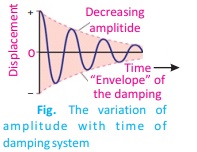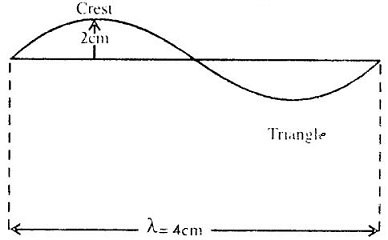Long Questions
Q.2 Think of several examples in everyday life of motion that are simple harmonic.
Q. 3 What are damped oscillations? How damping progressively reduces the amplitude oscillations?
Q. 5 Distinguish between longitudinal and transverse waves with suitable examples.
Q.9 Explain the following properties of a waves with reference to ripple tank experiment.
a. Reflection b. Refraction c. Diffraction
Q.11 If the length of a simple pendulum is doubled what will be the change in its time period?
Q.14 What types of waves do not require any material medium for their propagation?
Q. 15 Plane waves in the ripple tank undergo refraction when they move from deep to shallow water. What change occurs in the speed of the waves?
Q.1 What is simple-harmonic motion? What are the necessary conditions for a body to execute simple harmonic motion?
Answer: Simple Harmonic Motion:
The special kind of vibratory motion of a body, whose acceleration is directly proportional to its displacement from mean – equilibrium position, is called the simple harmonic motion.
Conditions for SHM:
- Acceleration is directly proportional to its displacement.
- Acceleration is directed towards the mean position.
Q.2 Think of several examples in everyday life of motion that are simple harmonic.
Answer: There are many examples which execute Simple Harmonic Motion (SHM):
Examples:
- Oscillating simple pendulum.
- Oscillating mass-spring system.
- A ball oscillating in a curved dish.
- Pendulum of wall clock.
Q. 3 What are damped oscillations? How damping progressively reduces the amplitude oscillations?
Answer: Damped Oscillations: “The continuous decrease of amplitude of oscillator is called damped oscillator and the oscillations are called damped  oscillations”.
oscillations”.
Real Oscillator: Simple harmonic oscillations are ideal. In case of real oscillator, there is continuous decrease of amplitude which ultimately becomes zero. it is due to resistance of medium in which the oscillator oscillates. This resistive force reduces the mechanical energy of the system as time passes. This resistive force is called damping force.
Q.4 How can you define the term wave? Elaborate the difference between mechanical and electromagnetic waves? Give examples of each.
Answer: Wave is the mean to transport energy from one place to another place without transport of matter.
Mechanical waves: The waves which require medium for their propagation.
For example: sound waves, water waves and rope waves.
Electromagnetic Waves:
The waves which don’t require any medium for their propagation. For example light waves are electromagnetic waves.
Q. 5 Distinguish between longitudinal and transverse waves with suitable examples.
Answer: The waves due to’ which the direction of oscillations are along, the direction, of propagation of waves are called “Longitudinal” waves. And if the direction of oscillations are perpendicular to the direction of propagation of waves are called transverse waves.
Examples of longitudinal waves:
(i) Sound waves.
(ii) Waves on slinky spring.
Examples of Transverse waves
(i) Water waves (ii) String waves
Q. 6 Draw transverse wave with amplitude of 2cm and a wavelength of 4cm. Label a crest and trough on the wave.
Q.7 Derive a relationship between speed, frequency and wavelength of a wave. Write a formula relating speed of a wave to its time period and wavelength.
Answer: We know the basic formula d = vt ——- (1)
For special case if d = λ
The time required for wave to travel distance λ is t = T
Putting in equation (1) we get λ = vT we know 1/T = f
So λ 1/T = v
v = f λ
Speed = Product of frequency and wavelength
Q.8 Waves are the means of energy transfer without transfer of matter. Justify this statement with the help of a simple experiment.
Answer: If we hold an end of a long string and give it vibrations. Then a wave is set up on the string and the other end also starts vibrating automatically (after
some time). It confirms the transfer of energy by the help of wave on string. It confirms the transfer of energy and not the transfer of mass.
Q.9 Explain the following properties of a waves with reference to ripple tank experiment.
a. Reflection b. Refraction c. Diffraction
Answer: a. Reflection:
The person in which, waves moving in one medium fall on the surface of another medium and these bounce back into the same first medium such that the angle of incidence is equal to the angle of reflection, is called reflection of waves.
b. Refraction: The process in which waves from one medium enter in the second medium at some angle their direction of travel may change is called refraction of waves.
c. Diffraction: “The bending or spreading of waves around the sharp edges or corners of obstacles is called diffraction”
Q.10 Does increasing the frequency of a wave also increases its wavelength? if not, how are these quantities related?
Answer: We know the relation v = f λ
It clearly shows if frequency increases then wavelength decreases because the product is constant that is velocity. Velocity is constant until medium is constant.
Q.11 If the length of a simple pendulum is doubled what will be the change in its time period?
Answer: As we know that

So

Hence Time Period is √2 times of time period.
Q.12 A ball is dropped from a certain height onto the floor and keeps bouncing. Is the motion of’ the ball simple harmonic? Explain.
Answer: As the ball is dropped from certain height “h” onto the floor having initial P.E = mgh and keeps bouncing. It is observed after each bounce its height and its P.E are decreasing. And lime period is also decreasing. As time period is not constant and total energy is not conserved so the motion of the ball is not simple harmonic motion.
Q.13 A student performed two experiments with a simple pendulum. He/She use two bobs of different masses by keeping other parameters constant. To his/ her astonishment the time period of the pendulum did not change! Why?
Answer: We know the formula of time period of a simple pendulum is ![]() The formula of time period of a simple pendulum shows that it is independent of mass of bob. By change of mass of bob no change in time period is expected.
The formula of time period of a simple pendulum shows that it is independent of mass of bob. By change of mass of bob no change in time period is expected.
Q.14 What types of waves do not require any material medium for their propagation?
Answer:Electromagnetic waves:
The waves which don’t require any medium for their propagation are called electromagnetic waves.
The X-ray, light waves, radio and T.V. waves are example of electromagnetic waves.
Q. 15 Plane waves in the ripple tank undergo refraction when they move from deep to shallow water. What change occurs in the speed of the waves?
Answer: When water waves coming from deeper portion of ripple tank enter into another region of shallow water region, then these show refraction. Their speed in both the regions is not same due to change of value of waves length.
